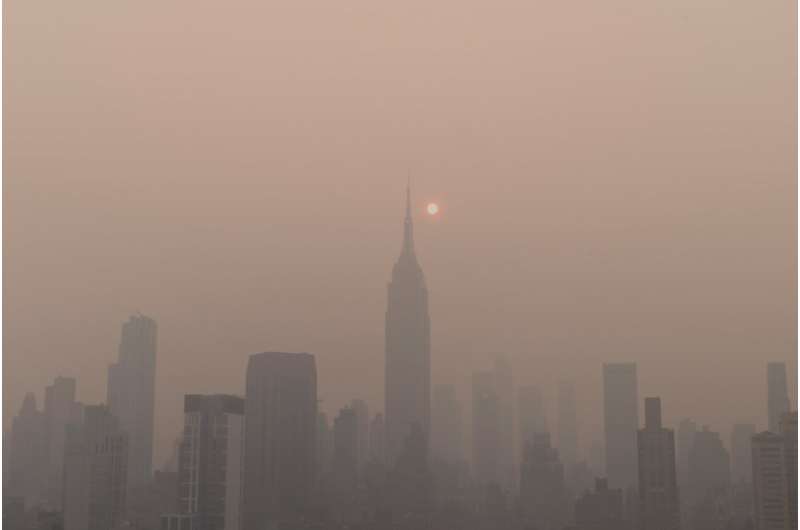This article has been reviewed according to Science X's editorial process and policies. Editors have highlighted the following attributes while ensuring the content's credibility:
fact-checked
trusted source
proofread
Research demonstrates benefits of decarbonization, renewable energy on public health outcomes

A noticeable change filled the air last summer—an actual change in air quality. Wildfires in Canada produced smoke-filled skies and wood-burnt, chemically scented air. National media showed images of orange-tinged skies in New York City and other urban areas. Unhealthy air quality plagued much of the United States during our hottest months, and at various times several U.S. cities had the worst air quality in the world.
Globally, air pollution contributes to more than 4 million deaths per year. Air pollution does not comply with health-based air quality standards for more than 100 million U.S. residents. Climate-driven conditions—like wildfires—are expected to worsen air pollution and air quality. Garvin Heath, principal environmental engineer and distinguished member of the research staff at the National Renewable Energy Laboratory (NREL), hopes to help change all that.
"Even in a country that has as clean of air as the United States generally does, a lot of the air pollution is caused by combustion, and combustion mostly originates from the energy system," Heath said in the recently released Long Story Short video. "As we think about exchanging renewables for conventional—especially fossil—energy, we're then clearing the skies because we're emitting less air pollutants."
Demonstrating benefits of decarbonization and renewable energy
Air quality research at NREL centers around quantifying the benefits of renewable energy and decarbonization strategies on public health outcomes. Understanding the air quality impacts on public health is key to evaluating policy interventions and prioritizing paths to pollution reduction. NREL's air quality research includes source-specific and regional air quality models, public health impact analyses, evaluation of co-benefits, and air quality-focused environmental justice and just energy transition analyses.
Quantifying the co-benefits of renewable energy and decarbonization strategies proved beneficial in the Los Angeles 100% Renewable Energy (LA100) study. In the study, researchers looked at pathways to achieve 100% renewable energy in the power sector, and simulations showed reductions in fine particulate matter concentrations equivalent to almost two decades of air pollution reduction efforts in LA.
These efforts provide actionable insights that can inform equitable policies and improve air quality in LA. Building on LA100, NREL has partnered with Lithuania to launch the Lithuania 100% Renewable Energy Study, which will also include an emphasis on air quality and public health analysis.
Addressing air quality-related health disparities
Just as important as quantifying the public health impacts of pollutants is understanding the disparities of the impacts between different communities and identifying paths to equalizing them.
"Different demographic groups experience air pollution in different ways," Heath said. "People of color and lower-income people have been shown in studies to experience higher degrees of air pollution and health related effects than their white counterparts. But that doesn't have to stay that way."
With various air quality analysis tools at their disposal, Heath and NREL air quality researchers provide a comprehensive view of air quality issues to help decision makers improve public health outcomes with an eye to maximizing benefits in terms of environmental justice when designing decarbonization plans.
Through his work as the co-lead of the Joint Institute for Strategic Energy Analysis Energy and Atmospheric Systems Catalyzer, Heath's team worked to further develop these tools and air quality analysis capabilities to spread the impact of this area of research. One such example is LA100 Equity Strategies, a follow-up to the LA100 study.
This study focused on heavy-duty transportation electrification as a way to reduce air pollutant emissions, concentrations, and health effects. Heavy-duty trucks travel in Los Angeles mostly on major roads like highways, which is correlated with where many disadvantaged communities are located. The study found that electrification of heavy-duty trucks should help to reduce air quality-related health disparities.
Modeling air quality effects on international health
Just as air does not stop at borders, NREL's air quality researchers have been working to help address air quality and public health concerns around the globe. NREL supported the expansion of a domestic air quality model to create the Global Intervention Model for Air Pollution (Global InMAP), which can quantify air quality and health changes anywhere in the world. The first application of Global InMAP was in the evaluation of renewable energy integration and transmission scenarios in Southeast Asia in a study conducted in partnership with the ASEAN Center for Energy, University of Minnesota, and USAID.
Separately, NREL has examined connections between electricity production and air quality in South and Central Asia, identifying policies that can mitigate the impact of power generation on air quality and public health. Researchers also analyzed the impacts of air pollution on solar power generation.
"When air quality is bad, people know it—they can see it, they can smell it, they can feel it, and it has effects on their health," Heath said. "If we can move away from emitting technologies to renewable energy sources, we're going to be able to decrease emissions and, therefore, decrease health effects that result from them."
Provided by National Renewable Energy Laboratory




















